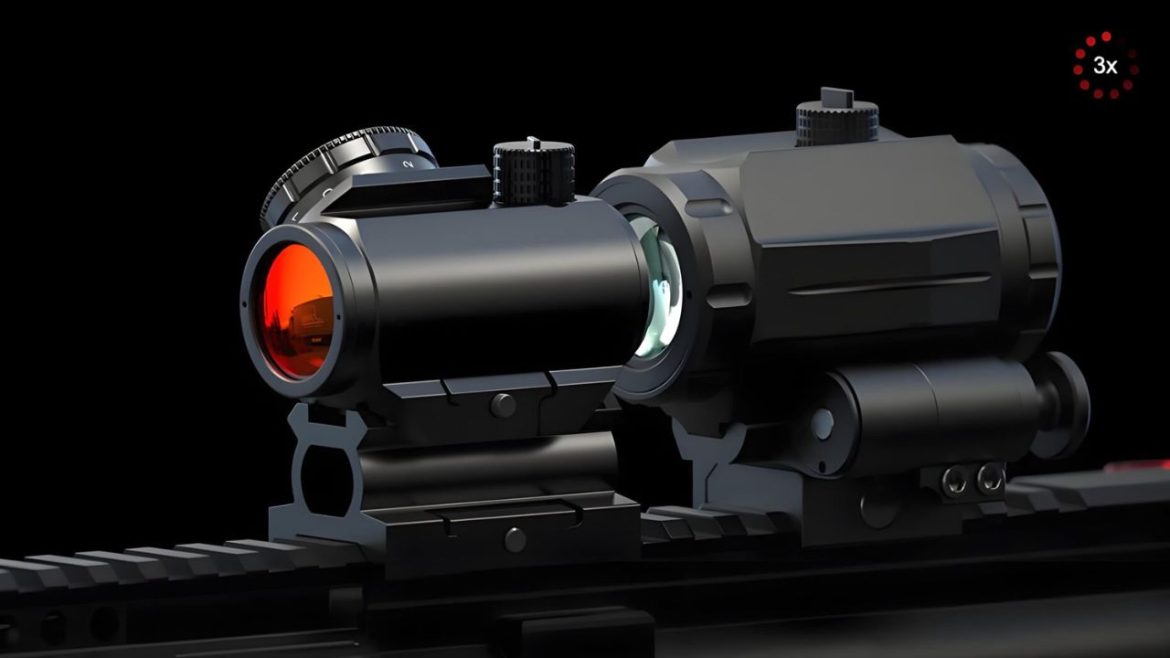Modern firearm optics have brought major advancements that deliver better accuracy and speed alongside enhanced versatility to shooters. The two most frequently used sighting systems include red dot sight and red dot magnifier. These two optics operate differently because they serve different functions although they share some initial visual similarities. Knowledge about these optics enables shooters to select equipment matching their particular requirements between tactical uses and competitive or hunting needs.
Understanding Red Dot Sights
A red dot sight functions as a non-magnified optic which creates a precise aiming point through its red or green illuminated dot. Through its red or green illuminated dot projection onto a lens, the shooter can keep both eyes open for target acquisition. The red dot sight finds its primary use in short to medium-distance shooting because it improves both speed and accuracy in target acquisition. The operation of red dot sights relies on a basic yet efficient system. The small LED light illuminates the specially treated lens that sends reflected illumination toward the shooter’s eyes. The system produces a floating dot that stays fixed on the target no matter where the shooter looks because of its parallax-free performance. The unlimited eye relief of red dot sights enables comfortable and flexible shooting compared to iron sights.
Understanding Magnifiers
The optical device known as a magnifier functions with red dot sights to deliver magnified views without changing the basic aiming framework. The function of a magnifier differs from scopes because it only enhances the view through the red dot sight without adding reticles or magnification features. Shooters can easily transition between short-range and extended-range targets because of this feature. The placement of magnifiers behind red dot sights allows users to activate or deactivate them according to their current requirements. The device both enlarges the target and the red dot so users can easily aim at distant targets. Users can achieve precise magnification through adjustable focus and diopter settings which are standard features on most magnifiers. The optics provide valuable features to shooters who need flexible equipment setups. Law enforcement officers together with military personnel and hunters depend on magnifiers to extend their effective range without compromising the quick aiming capabilities of red dot sights during close combat situations. The integration between magnifiers and red dot sights remains seamless because these devices do not require any modifications to zero settings.
Key Differences in Functionality
The main distinction between red dot sights and magnifiers stems from their purpose in use. A red dot sight operates independently to deliver quick target acquisition capabilities for distances ranging from short to medium. A magnifier enables red dot sight users to hit distant targets with improved visibility. Red dot sights function best when users keep both eyes open which allows them to maintain situational awareness and increase their speed. Shooting with a magnifier demands the user to aim through one eye during magnification which results in a minor reduction of peripheral vision. The trade-off enables better accuracy when aiming at distant targets. Their practical use represents a major distinction between red dot sights and magnifiers. The fast-paced nature of tactical situations home defense and competitive shooting events makes red dot sights the optimal choice. Magnifiers provide users with additional flexibility because they work effectively when targets appear at different distances. Shooters maintain their speed by using the side-flipping mechanism of magnifiers during periods when they do not require magnification.
Considerations for Choosing Between a Red Dot Sight and a Magnifier
Shooters need to evaluate their requirements along with their shooting conditions before choosing between red dot sights and magnifiers. Shooters who focus on targets within short to medium ranges should choose a red dot sight because it offers fast operation and a user-friendly design. A magnifier serves as an ideal choice for shooters who occasionally require magnification but prefer not to use a traditional scope. Weight and bulk dimensions play significant roles in the selection process. A red dot sight functions as a lightweight and compact device that provides excellent maneuverability. A magnifier adds both weight and length to the firearm which might result in handling challenges. Agility-focused shooters tend to choose standalone red dot sights yet range-demanding shooters might accept additional weight to gain extended sight range through the use of magnifiers.
Conclusion
Modern shooting setups benefit from red dot sights and magnifiers although these devices fulfill different operational functions. A red dot sight enables quick and precise aiming at short to medium distances yet a magnifier extends red dot sight effectiveness by enabling longer-range shooting. The knowledge of these two optics enables shooters to select equipment that matches their requirements and usage needs. The selection of appropriate optics based on speed, precision or versatility needs ensures shooters achieve their best possible shooting experience.
